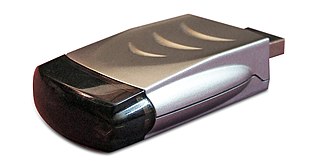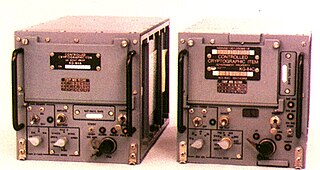Telecommunications in Uruguay includes radio, television, telephones, and the Internet.

The Infrared Data Association (IrDA) is an industry-driven interest group that was founded in 1993 by around 50 companies. IrDA provides specifications for a complete set of protocols for wireless infrared communications, and the name "IrDA" also refers to that set of protocols. The main reason for using IrDA had been wireless data transfer over the "last one meter" using point-and-shoot principles. Thus, it has been implemented in portable devices such as mobile telephones, laptops, cameras, printers, and medical devices. Main characteristics of this kind of wireless optical communication is physically secure data transfer, line-of-sight (LOS) and very low bit error rate (BER) that makes it very efficient.
A leased line is a private bidirectional or symmetric telecommunications circuit between two or more locations provided in exchange for a monthly rent. Sometimes known as a private circuit or data line in the UK.

PROFIBUS is a standard for fieldbus communication in automation technology and was first promoted in 1989 by BMBF and then used by Siemens. It should not be confused with the PROFINET standard for Industrial Ethernet. PROFIBUS is openly published as part of IEC 61158.

STU-III is a family of secure telephones introduced in 1987 by the NSA for use by the United States government, its contractors, and its allies. STU-III desk units look much like typical office telephones, plug into a standard telephone wall jack and can make calls to any ordinary phone user. When a call is placed to another STU-III unit that is properly set up, one caller can ask the other to initiate secure transmission. They then press a button on their telephones and, after a 15-second delay, their call is encrypted to prevent eavesdropping. There are portable and militarized versions and most STU-IIIs contained an internal modem and RS-232 port for data and fax transmission. Vendors were AT&T, RCA and Motorola.

The TSEC/KW-26, code named ROMULUS, was an encryption system used by the U.S. Government and, later, by NATO countries. It was developed in the 1950s by the National Security Agency (NSA) to secure fixed teleprinter circuits that operated 24 hours a day. It used vacuum tubes and magnetic core logic, replacing older systems, like SIGABA and the British 5-UCO, that used rotors and electromechanical relays.
The Secure Communications Interoperability Protocol (SCIP) is a multinational standard for secure voice and data communication, for circuit-switched one-to-one connections, not packet-switched networks. SCIP derived from the US Government Future Narrowband Digital Terminal (FNBDT) project after the US offered to share details of FNBDT with other nations in 2003. SCIP supports a number of different modes, including national and multinational modes which employ different cryptography. Many nations and industries develop SCIP devices to support the multinational and national modes of SCIP.
BATON is a Type 1 block cipher in use since at least 1995 by the United States government to secure classified information.
The vast majority of the National Security Agency's work on encryption is classified, but from time to time NSA participates in standards processes or otherwise publishes information about its cryptographic algorithms. The NSA has categorized encryption items into four product types, and algorithms into two suites. The following is a brief and incomplete summary of public knowledge about NSA algorithms and protocols.
HomePlug is the family name for various power line communications specifications under the HomePlug designation, with each offering unique performance capabilities and coexistence or compatibility with other HomePlug specifications.

A secure telephone is a telephone that provides voice security in the form of end-to-end encryption for the telephone call, and in some cases also the mutual authentication of the call parties, protecting them against a man-in-the-middle attack. Concerns about massive growth of telephone tapping incidents led to growing demand for secure telephones.
A TACLANE is a family of Inline Network Encryptors (INE) developed and manufactured by General Dynamics Mission Systems to meet the National Security Agency (NSA) requirements for High Assurance Internet Protocol Encryptor.
OMNI is an encryption device manufactured by L-3 Communications. It adds secure voice and secure data to any standard analog telephone or modem connected computer.
A High Assurance Internet Protocol Encryptor (HAIPE) is a Type 1 encryption device that complies with the National Security Agency's HAIPE IS. The cryptography used is Suite A and Suite B, also specified by the NSA as part of the Cryptographic Modernization Program. HAIPE IS is based on IPsec with additional restrictions and enhancements. One of these enhancements includes the ability to encrypt multicast data using a "preplaced key". This requires loading the same key on all HAIPE devices that will participate in the multicast session in advance of data transmission. A HAIPE is typically a secure gateway that allows two enclaves to exchange data over an untrusted or lower-classification network.
The Cryptographic Modernization Program is a Department of Defense directed, NSA Information Assurance Directorate led effort to transform and modernize Information Assurance capabilities for the 21st century. It has three phases:

The United Kingdom has been involved with the Internet since it was created. The telecommunications infrastructure provides Internet access to businesses and home users in various forms, including cable, DSL, and wireless. The Internet country code top-level domain (ccTLD) for the United Kingdom is .uk and is sponsored by Nominet.
The Joint Range Extension Applications Protocol ("JREAP") enables tactical data messages to be transmitted over long-distance networks, e.g. satellite links, thereby extending the range of Tactical Data Links (TDLs).
FASCINATOR is a series of Type 1 encryption modules designed in the late-1980s to be installed in Motorola digital-capable voice radios. These radios were originally built to accept a DES-based encryption module that was not approved by NSA for classified communications. The FASCINATOR modules replaced the DES units and can be used for classified conversations at all levels when used with appropriately classified keys. FASCINATOR operates at 12 kbit/s for encryption and decryption. It is not compatible with DES-based voice systems.

The Committee on National Security Systems (CNSS) is a United States intergovernmental organization that sets policy for the security of the US security systems.

Cryptography or cryptology is the practice and study of techniques for secure communication in the presence of third parties called adversaries. More generally, cryptography is about constructing and analyzing protocols that prevent third parties or the public from reading private messages; various aspects in information security such as data confidentiality, data integrity, authentication, and non-repudiation are central to modern cryptography. Modern cryptography exists at the intersection of the disciplines of mathematics, computer science, electrical engineering, communication science, and physics. Applications of cryptography include electronic commerce, chip-based payment cards, digital currencies, computer passwords, and military communications.
The National Security Agency took over responsibility for all U.S. Government encryption systems when it was formed in 1952. The technical details of most NSA-approved systems are still classified, but much more about its early systems have become known and its most modern systems share at least some features with commercial products.









